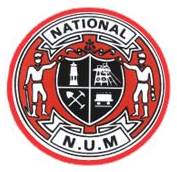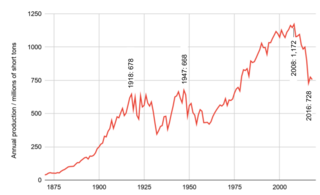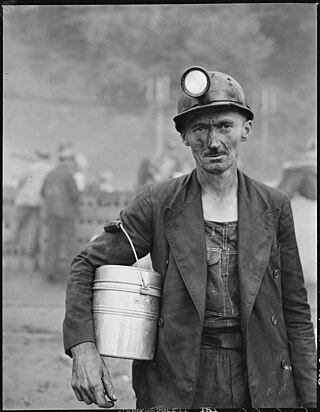Books and some articles relating to coal mining, especially historical.
{{cite book}}: CS1 maint: location (link)
Anthracite, also known as hard coal and black coal, is a hard, compact variety of coal that has a submetallic lustre. It has the highest carbon content, the fewest impurities, and the highest energy density of all types of coal and is the highest ranking of coals.

Coal mining is the process of extracting coal from the ground or from a mine. Coal is valued for its energy content and since the 1880s has been widely used to generate electricity. Steel and cement industries use coal as a fuel for extraction of iron from iron ore and for cement production. In the United Kingdom and South Africa, a coal mine and its structures are a colliery, a coal mine is called a "pit", and above-ground mining structures referred to as a "pit head". In Australia, "colliery" generally refers to an underground coal mine.

John Llewellyn Lewis was an American leader of organized labor who served as president of the United Mine Workers of America (UMW) from 1920 to 1960. A major player in the history of coal mining, he was the driving force behind the founding of the Congress of Industrial Organizations (CIO), which established the United Steel Workers of America and helped organize millions of other industrial workers in the 1930s, during the Great Depression. After resigning as head of the CIO in 1941, thus keeping his promise of resignation if President Franklin Delano Roosevelt won the 1940 election against Wendell Willkie, Lewis took the United Mine Workers out of the CIO in 1942 and in 1944 took the union into the American Federation of Labor (AFL).

The United Mine Workers of America is a North American labor union best known for representing coal miners. Today, the Union also represents health care workers, truck drivers, manufacturing workers and public employees in the United States and Canada. Although its main focus has always been on workers and their rights, the UMW of today also advocates for better roads, schools, and universal health care. By 2014, coal mining had largely shifted to open pit mines in Wyoming, and there were only 60,000 active coal miners. The UMW was left with 35,000 members, of whom 20,000 were coal miners, chiefly in underground mines in Kentucky and West Virginia. However it was responsible for pensions and medical benefits for 40,000 retired miners, and for 50,000 spouses and dependents.

The National Union of Mineworkers (NUM) is a trade union for coal miners in Great Britain, formed in 1945 from the Miners' Federation of Great Britain (MFGB). The NUM took part in three national miners' strikes, in 1972, 1974 and 1984–85. Following the 1984–85 strike, and the subsequent closure of most of Britain's coal mines, it became a much smaller union. It had around 170,000 members when Arthur Scargill became leader in 1981, a figure which had fallen in 2023 to an active membership of 82.
The history of coal mining goes back thousands of years, with early mines documented in ancient China, the Roman Empire and other early historical economies. It became important in the Industrial Revolution of the 19th and 20th centuries, when it was primarily used to power steam engines, heat buildings and generate electricity. Coal mining continues as an important economic activity today, but has begun to decline due to the strong contribution coal plays in global warming and environmental issues, which result in decreasing demand and in some geographies, peak coal.

The Coal strike of 1902 was a strike by the United Mine Workers of America in the anthracite coalfields of eastern Pennsylvania. Miners struck for higher wages, shorter workdays, and the recognition of their union. The strike threatened to shut down the winter fuel supply to major American cities. At that time, residences were typically heated with anthracite or "hard" coal, which produces higher heat value and less smoke than "soft" or bituminous coal.

In the Lattimer massacre, at least 19 unarmed striking immigrant anthracite miners were killed violently at the Lattimer mine near Hazleton, Pennsylvania, United States, on September 10, 1897. The miners, mostly of Polish, Slovak, Lithuanian and German ethnicity, were shot and killed by a Luzerne County sheriff's posse. Scores more workers were wounded. The massacre was a turning point in the history of the United Mine Workers (UMW).

The South Wales Coalfield extends across Pembrokeshire, Carmarthenshire, Swansea, Neath Port Talbot, Bridgend, Rhondda Cynon Taf, Merthyr Tydfil, Caerphilly, Blaenau Gwent and Torfaen. It is rich in coal deposits, especially in the South Wales Valleys.
The bituminous coal miners' strike was an unsuccessful national eight-week strike by miners of bituminous coal in the United States, which began on April 21, 1894.

A breaker boy was a coal-mining worker in the United States and United Kingdom whose job was to separate impurities from coal by hand in a coal breaker.

The history of coal mining in the United States starts with the first commercial use in 1701, within the Manakin-Sabot area of Richmond, Virginia. Coal was the dominant power source in the late 1800s and early 1900s, and although in rapid decline it remains a significant source of energy in 2023.
George Korson was a folklorist, journalist, and historian. He has been cited as a pioneer collector of industrial folklore, and according to Michael Taft of the Library of Congress, "may very well be considered the father of occupational folklore studies in the United States." In addition to writing and editing a number of influential books, he also issued his field recordings of coal miners on two LP records for the Library of Congress.

The Avondale Mine disaster was a massive fire at the Avondale Colliery near Plymouth Township, Pennsylvania, on September 6, 1869. It caused the death of 110 workers. It started when the wooden lining of the mine shaft caught fire and ignited the coal breaker built directly overhead. The shaft was the only entrance and exit to the mine, and the fire trapped and suffocated 108 of the workers. It was the greatest mine disaster to that point in American history.

Coal mining in the United Kingdom dates back to Roman times and occurred in many different parts of the country. Britain's coalfields are associated with Northumberland and Durham, North and South Wales, Yorkshire, the Scottish Central Belt, Lancashire, Cumbria, the East and West Midlands and Kent. After 1972, coal mining quickly collapsed and had practically disappeared by the 21st century. The consumption of coal—mostly for electricity—fell from 157 million tonnes in 1970 to 18 million tonnes in 2016, of which 77% was imported from Colombia, Russia, and the United States. Employment in coal mines fell from a peak of 1,191,000 in 1920 to 695,000 in 1956, 247,000 in 1976, 44,000 in 1993, and to 2,000 in 2015.

People have worked as coal miners for centuries, but they became increasingly important during the Industrial revolution when coal was burnt on a large scale to fuel stationary and locomotive engines and heat buildings. Owing to coal's strategic role as a primary fuel, coal miners have figured strongly in labor and political movements since that time.
The 1927 Indiana bituminous strike was a strike by members of the United Mine Workers of America (UMWA) against local bituminous coal companies. Although the struggle raged throughout most of the nation's coal fields, its most serious impact was in western Pennsylvania, including Indiana County. The strike began on April 1, 1927, when almost 200,000 coal miners struck the coal mining companies operating in the Central Competitive Field, after the two sides could not reach an agreement on pay rates. The UMWA was attempting to retain pay raises gained in the contracts it had negotiated in 1922 and 1924, while management, stating that it was under economic pressure from competition with the West Virginia coal mines, was seeking wage reductions. The strike proved to be a disaster for the union, as by 1929, there were only 84,000 paying members of the union, down from 400,000 which belonged to the union in 1920.

There are two types of coal found in Pennsylvania: anthracite, the hard coal found in Northeastern Pennsylvania below the Allegheny Ridge southwest to Harrisburg, and bituminous, the soft coal found west of the Allegheny Front escarpment). Anthracite coal is a natural mineral with a high carbon and energy content that gives off light and heat produced energy when burned, making it useful as a fuel. It was possibly first used in Pennsylvania as a fuel in 1769, but its history begins with a documented discovery near Summit Hill and the founding of the Lehigh Coal Mine Company in 1792 to periodically send expeditions to the wilderness atop Pisgah Ridge to mine the deposits, mostly with notable lack of great success, over the next 22 years.
The Federal Coal Commission was an agency of the Federal government of the United States of America, enacted by the U.S. Congress in September 1922 and headed by former U.S. Vice President Thomas R. Marshall.

The 1922 UMW Miner strike or The Big Coal Strike was a nationwide general strike of miners in the US and Canada after the United Mine Worker's (UMW) trade union contract expired on March 31, 1922. The strike decision was ordered March 22, to start effective April 1. Around 610,000 mine workers struck. About 100,000 of the striking miners were non-union or not associated with the UMW.